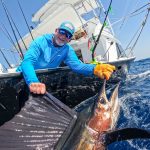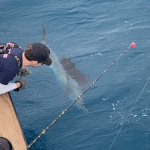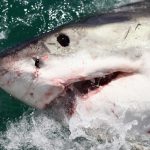03 AUG 2008 NY to VA Region Special Analysis PDF
03 AUG 2008 Wilmington to Norfolk Canyon Analysis PDF
ROFFS™ FISHERIES OCEANOGRAPHIC ANALYSIS – SPECIAL WHITE MARLIN OPEN
FOR THE NEW YORK TO VIRGINIA REGION UPDATED ON SUNDAY. 03 AUG 2008
We were able to see this area clearly this morning before the clouds obscured our view. We are providing this so that you can have the regional view of the ocean conditions. We decided to use Saturday’s satellite infrared imagery and Friday’s ocean color imagery since this allows for a more complete view compared with today. There will be some changes between these days and from today’s analysis. But for the regional view this imagery provides the best views. For our clients who requested their analyses in color we are providing the infrared analysis for sea surface temperature (SST) and the ocean color – chlorophyll + colorized dissolved organic matter (CDOM) image.
For our clients who ordered black and white fax, only the SST analysis is being sent. If you would like to receive the color image analysis please call the office and we will be happy to send the color analysis via email.
The most obvious feature is the clockwise rotating Gulf Stream eddy located offshore of the Spencer Canyon to Hudson Canyon. This is the source of the blue water and the good fishing action the last three weeks over the Toms Canyon to Carteret Canyon. This eddy has shed three bands of blue water and the first band has reached the Wilmington Canyon this week due in part to a short-lived counter-clockwise eddy that existed over the 1000 fathom depths of the Wilmington earlier this week, but degenerated Thursday. Presently there is another counter-clockwise rotating pool of water centered over the 1000
fathom depths between the Wilmington Canyon and the Baltimore Canyon that is pulling the blue Gulf Stream water from the Spencer Canyon to the eastern side of the Wilmington Canyon. This water has
been providing the conditions for relatively good white marlin and blue marlin, along with tuna and dolphin action the last few days. While it remains to be seen if the water and fish will move to the Baltimore Canyon, there has been good fishing action along the boundary of the blue water from the 40 fathom depths of Spencer Canyon and Wilmington Canyon to the 100-750 fathom depths of the Wilmington
Canyon. There also has been fishing action over the 100 fathom depths of the Spencer Canyon. It remains to be seen how long this counter-clockwise circulation will continue. If the center of circulation
chances, then the critical direction of the flow of the water will change affecting the fishing action. The Baltimore Canyon for the last few weeks has not provided good fishing action. However, we anticipate that the Baltimore Canyon area fishing action will improve this week whether the blue water reaches the canyon or not. The fishing action over the Poor Mans Canyon for the past few weeks has not provided good fishing action as well. However, the presence of the pool of blue water over the 500-1000 fathom depths suggests that fishing action is likely. The Washington Canyon has sporadically provided good fishing action during this past week. It remains to be seen if the relatively small white marlin that have been residing between the Washington Canyon and the Norfolk Canyon (and south) will concentrate over the Washington Canyon. The white marlin action over the Norfolk Canyon area, both north, over the canyon and south has been sporadically good for the past ten days. These relatively small fish have been associated with pods of bait (Spanish sardines, squid, etc). The water mass boundaries had been stable north of the canyon, but not stable south. The pods of bait fish and the fishing action have been moving substantially each day. Perhaps if the water mass boundaries stabilize that the fishing action will be more constant and concentrated. Note that the Gulf Stream occurs over the 1500 fathom depths southeast of the Norfolk Canyon.
Presently we do not see any evidence of a substantial meander forming that would generate a Gulf Stream filament or eddy. These features are first seen east of Oregon Inlet and develop into larger features. We will be monitoring any change in these conditions.
We did not provide a trace for the ocean color – chlorophyll + CDOM image from Friday. Almost all of the water available in this tournament is either a clear blue-green or blue colored. Note that there is green
turbid water centered near 73°25’W & 38°50’N. While most of this water is likely to be pulled northeastward by the large Gulf Stream eddy, some of this water is being pulled southward between the Elephant’s Trunk and the Wilmington Canyon. We will monitor the water color and clarity as we have been doing for the past several years. It is likely that this turbid water will be pulled between the Baltimore
Canyon and the Wilmington Canyon as a function of the counter-clockwise circulation centered over the 1000 fathom depths between the Wilmington Canyon and Baltimore Canyon areas.
THANK YOU FOR NOT SHARING THIS ANALYSIS AND OTHER ANALYSES WITH NON-PAYING FISHERMEN. WE SURVIVE ON YOUR HONESTY. VERBAL UPDATES ARE FREE BETWEEN
10:30 A.M. AND 11:59 A.M. PLEASE CALL.
Remember you can order your fishing analyses via email or from our website. SUMMER office hours: Mon. – Fri. 9:00 AM – 09:00 PM. Saturday hours: 9:00 AM – 5:00 PM, but sometimes we will close earlier depending
on demand, clouds, weather. For Saturday analyses, requests for analysis areas that have not been prescheduled should be requested on Saturdays by noon, so we can schedule our staff’s hours.
ROFFS™ FISHERIES OCEANOGRAPHIC ANALYSIS
FOR THE WILMINGTON CANYON TO NORFOLK CANYON OFFSHORE (LAT./LONG.)
UPDATED ON SUN. 03 AUG 2008 FOR SUN. P.M. & MON. FISHING ONLY
Based on a multiple factor analysis, the symbols (hot spot dots) mark the areas where the symbols (hot spot dots) mark the areas where bait concentrations are expected and where fishing action is expected to be better compared with other (non-marked) areas. These are not based on dock rumors or hearsay fishing reports. Fishing reports are stated as such.
You should start fishing where you recognize other signs of good fishing conditions near these marked areas. It is very important to use your sea surface temperature (sst°) gauge to locate the boundaries of the water masses, which are outlined. Rather than trying to find water based on the absolute temperature values shown on the map, search for the relative change in sst where the water mass boundaries occur. Arrows indicate the main current direction. Numbers inside of the dots indicate the number of consecutive days that we have seen favorable conditions in that location. Broken lines (small dotted lines) are water mass boundaries detected from the ocean color (chlorophyll + colorized dissolved organic material or “CDOM”) satellite data. Daytime sst are likely to warm 2°F-3°F. We were able to see this area this afternoon using infrared (sst) and ocean color which helped us overcome the haze interference that trailed the clouds as they moved eastward. The counter-clockwise circulation that was centered over the 1000 fathom curve of the South Heyes Canyon yesterday was seen this afternoon centered over the 1000 fathom curve near 73°25’W & 37°55’N. While it remains to be seen if this feature will continue moving southwestward overnight, the important aspect is that it is continuing to pull blue blended Gulf Stream eddy water southward from Spencer Canyon over the Wilmington Canyon and the eastern side (today) of the Baltimore Canyon. Good to excellent fishing action has been reported by several non-tournament fishermen over the 500-750 fathom depths of the North Heyes Canyon and South Heyes canyon the last two days that was associated with the leading edge of the blue water as it was being pulled southward over the eastern side of the Wilmington Canyon. Today that leading edge is over the western side of the Wilmington Canyon and northeast side of the Baltimore Canyon. While there is likely to be fishing action over the 500-750 fathom depths over the Heyes Canyons, we anticipate that fishing action is likely to be concentrated over the areas where the water mass boundaries have been concentrating the bait fish for the last several days. This suggests that the 50-100 fathom tip of the Wilmington Canyon, which has had favorable water mass boundary conditions for the last five consecutive days provides good chances for fishing action. There has been fish caught over this area the last few days. Unfortunately the flow of the water is southward and away from the ledges which is not a favorable direction. The western wall of the Wilmington Canyon near 73°35’W & 38°25’N has had both favorable water mass boundary and current direction conditions the last four days suggesting that good chances occur there, as well as, over the 70 fathom curve near 73°38’W & 38°22’N. Northeast of the Wilmington Canyon the flow of the water is northward and into the ledges, but the water mass boundary has only been there one day. More time is needed to concentrate the fish. It is important to note the presence of dirty green water over the eastern side of the Elephant’s Trunk to the 40-60 fathom depths west of the Wilmington Canyon. We had originally thought that this water would move between the Wilmington Canyon and the Baltimore Canyon, but as the offshore counter-clockwise circulation moved southward, we anticipate that this water will flow over the western side of the Baltimore Canyon. Inshore your chances for fishing action remain excellent over the Hambone Lump near 74°25’W & 38°13’N (two weeks favorable) and the Sausage Lumps near 74°24’W & 38°04’N (6th consecutive day favorable). Over the northeastern side of the Baltimore Canyon there has been favorable water mass boundary conditions for the second consecutive day and if the center of the offshore circulation does not move southward, then the flow of the water will be favorable which suggests that your chances for fishing action will be improved there. Note that over the 100 fathom curve near 73°49’W & 38°09’N that a water mass boundary has resided for the last four days. If the turbid green water does not override this area, then good chances for fishing action occur. Some fishing action is also likely over the 500 fathom ledge south side of the Baltimore Canyon (near 73°45’W & 38°92’N), the 600 fathom lumps near 73°35’W & 38°02’N, as well as, the 1000 fathom curve from Rusty’s Spot (73°25’w & 38°03’N) to 73°30’W & 38°00’N. Over the Poor Mans Canyon the pool of blue water that was over the northern section of the 500 fathom curve was pulled offshore. However, we have seen a water mass boundary near 74°06’W & 37°44’W for the last three days. While the flow of the water is offshore, there still is likely to be some
fishing action there. The conditions over the Washington Canyon have declined over the last 24 – 36
hours. In this area your chances will be better over the 30 fathom curve by the Merida Wreck (near
74°40’W & 37°22’N). Further south closer to the Norfolk Canyon there has been a favorable water mass
boundary over the 50-250 fathom depths the last two weeks. While this water is slowly drifting eastward,
your chances for fishing action are good near 74°32’W & 37°08’N. The conditions around the Norfolk
Canyon area have become more favorable for the sporadically good white marlin action (with small white
marlin) to start concentrating. Your chances for fishing action will be increased over the 30-35 fathom
depths near 74°50’W & 37°06-03’N, and 74°47’W & 36°58’N. It is likely that more marlin will enter this
area due to the proximity of the blue water located northwest of the Gulf Stream. Thank you for not sharing this analysis with non-paying fishermen. We survive on your
honesty. Verbal updates are free between 10:30 a.m. and 11:59 a.m. please call. Remember you
can request, order and/or download your fishing analyses from our website (roffs.com). Thank you for not
sharing this analysis with non-paying fishermen. We survive on your honesty. Verbal updates are free between 10:30
a.m. and 11:59 a.m. please call. Remember you can order your fishing analyses via email or from our website. SUMMER
office hours: Mon. – Fri. 9:00 AM – 09:00 PM. Saturday hours: 9:00 AM – 5:00 PM, but sometimes we will close earlier
depending on demand, clouds, weather. For Saturday analyses, requests for analysis areas that have not been prescheduled
should be requested on Saturdays by noon, so we can schedule our staff’s hours.







